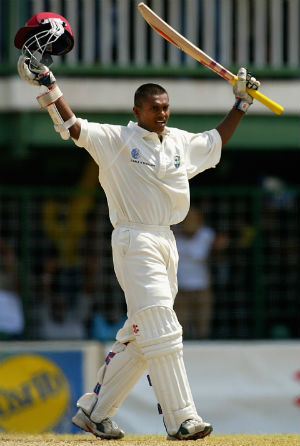On April 10, 2003 Shivnarine Chanderpaul scored the fourth-fastest hundred of all time at Bourda. Abhishek Mukherjee looks back at the day when the all-conquering Australians were bludgeoned by the person they had least expected to.
As far as style is concerned, Shivnarine Chanderpaul is way, way different from any batsman to have played for his illustrious team. To think of it, there hasn’t been a single batsman that has ever batted like him. Right from hammering a bail on the crease to mark his guard by banging the top of his bat handle, or that extremely odd-looking side-on stance of his, the West Indian left-hander has always been different from anyone else.
Chanderpaul has bailed West Indies out on innumerable occasions, and his statistics are comparable to the other great West Indian southpaw with whom he had a substantial overlap — Brian Lara. However, despite the fact that Lara is mentioned as one of the all-time greats, Chanderpaul has seldom been considered even as a contemporary great.
They say that Chanderpaul lacks the flair and exuberance of a great batsman. They say he cannot take a bowling to the cleaners the way great batsmen are supposed to do. They say he lacks aggression. When they say all that, they possibly do not take into account the proceedings of April 10, 2003.
The build-up
Australia had just won the World Cup, and with Steve Waugh back at the helm, they were all set to resume their journey as the all-conquering Test side in the world. Shane Warne was still serving his ban — and Glenn McGrath was at the bedside of his ailing wife, so Waugh decided to go in with five bowlers — Brett Lee, Jason Gillespie, Andy Bichel, Brad Hogg, and Stuart MacGill.
The West Indies, on the other hand, were a shadow of the side they used to be a decade back, or even the 1999 side, only four years back. There wasn’t Curtly Ambrose or Courtney Walsh to run through the opposition, and the possibility of a victory seemed bleak.
Lara won the toss and decided to bat on what looked like a flat wicket. The demolition did not take long to begin: in the fifth over Devon Smith was trapped in front of the stumps by Lee, and Rudi Koertzen gave what looked like a close leg-before decision. In the very next over Darren Ganga was clean bowled by one from Gillespie that kept low.10 for two.
Out came Lara to join Wavell Hinds, and the mood changed. He hit Lee for a four, and then hit Gillespie for two more in the next over. Waugh brought on Bichel, and Lara immediately hit him for two more in his first over. Sensing that things were going a bit too far, Waugh brought on Hogg.
Hinds hit out — somewhat irresponsibly — to Justin Langer at mid-off. Marlon Samuels edged Hogg to Matthew Hayden at first slip, Chanderpaul walked out to join Lara with the score on 47 for four.
The innings
He got off the mark with a flick off Hogg to keep the strike. Bichel bowled a good-length in the first ball of the next over, and Chanderpaul punched if off the back-foot past mid-on for a four. That one stroke possibly showed the kind of sublime touch he was in.
He took a single, and then disaster struck: Bichel found Lara’s pads; Asoka de Silva thought for a while, and gave Lara out in what looked like a dubious decision. The score was 53 for five when Ridley Jacobs walked out to join Chanderpaul.
The Australians had probably counted the chickens a bit too soon. They never realised what was in store for them. Lee replaced Hogg, and was pulled with utter disdain for a four. At the other end, Bichel was dispatched for two consecutive boundaries. Chanderpaul had raced to 24 from 14 balls, and was looking menacing.
Waugh brought back Hogg, but to no avail. The ball spun away from Chanderpaul, and he cut it so hard that it came back a significant distance after thudding into the fence. The awestruck crowd gasped, unable to fathom exactly what was going on. Was this the local lad they were used to see?
Waugh brought on MacGill; the leg-spinner tossed one up outside the off-stump, and Chanderpaul unearthed yet another shot from his repertoire — a massive slog-sweep over mid-wicket that flew into the Bourda stands. The 50 came up with that six, off just 37 balls, with seven fours and a six.
The carnage continued. Hogg was smashed for two brutal fours the next over, and in the one after that, Chanderpaul slog-swept MacGill again for a huge six — this time over square-leg. The next ball was tossed up on the off-stump, Chanderpaul brought his right foot forwards, and hit it absolutely straight. The timing was perfect, and the ball raced to the fence. MacGill tried a short one next ball: Chanderpaul got down on his right knee, found the ball too short for a conventional sweep, and raised the bat a bit to bring out an innovative sweep that beat the fine-leg for another four. He was on 75 from 48 now.
Waugh brought back Gillespie. He ran in, bowled one short that rose steeply, but there was no stopping Chanderpaul. He got on top the ball, and the ball sped across the turf to cross the ropes.
A wide one from MacGill was dispatched through extra-cover. He took a brace two balls later, and when MacGill tossed another one up outside off-stump, and as the ball skidded through extra-cover yet again, the bat was raised, the helmet was taken off, and the ground was kissed. Jacobs went up to hug him, and the crowd, the dressing-room, and even the fielders cheered in unison: the hundred had come up in 69 balls, the third-fastest of the time (Adam Gilchrist’s blitz later pushed it to the fourth slot).
Three balls later he tried to shove Bichel through mid-on, missed the line and slipped, and the ball hit his knee. Asoka de Silva’s finger went up, and the fielders huddled as the great man dropped down to the ground in pain. He was cordoned off the pitch by the physiotherapist, and the 72-ball 100 had come to an end.
Shivnarine Chanderpaul winces in pain on the ground after a ball from Andy Bichel hit his knee © Getty Images
Chanderpaul had hit 15 fours and two sixes, and had scored 100 out of 137 scored during his tenure at the wicket. He had added 131 with Jacobs in 141 balls, and had helped reach West Indies to a sizeable total. He had not spared any bowler. His bowler-by-bowler numbers read:
Eight off four balls from Lee, one four
10 off eight balls from Gillespie, one four
15 off 11 balls from Bichel, three fours
25 off 24 balls from Hogg, four fours
42 off 25 balls from MacGill, six fours and two sixes
What happened next?
West Indies were bowled out for 237, with all five bowlers taking wickets. Langer (146) and Ricky Ponting (117) added 248 for the second wicket, Adam Gilchrist had a late blitz, and Australia scored 489, securing a 252-run lead despite Vasbert Drakes’ five for 93.
Batting for the second time, Smith started well, and Ganga (113) and Lara (110) put up 185 for the second wicket, but West Indies collapsed from 295 for two (and later, 382 for five on the fourth morning) to 398, Gillespie picking up five for 39. Australia polished off the 147 runs for the loss of Hayden, and went on to take a 1-0 lead on the fourth afternoon.
April 10 and Chanderpaul
Exactly five years later Chanderpaul had an encore, pulling off a sensational victory on the same date — against Sri Lanka in an ODI. With 10 runs required from the last two balls, Chanderpaul smashed Chaminda Vaas for a four and six at Queen’s Park Oval to pull off one of the most unbelievable finishes.
It was a pity that there was no international match on April 10, 2013. The world of cricket missed out on watching Chanderpaul in his elements. We will have to wait for another five years, I guess — and trust me, he will try his heart out to be still there, trying to bail West Indies out of trouble for what would be the umpteenth time or so.
Brief scores: West Indies 237 (Shivnarine Chanderpaul 100, Ridley Jacobs 54) and 398 (Darren Ganga 113, Brian Lara 110; Jason Gillespie 5 for 39) lost to Australia 489 (Justin Langer 146, Ricky Ponting 117, Adam Gilchrist 77; Vasbert Drakes 5 for 93) and 147 for 1 (Justin Langer 78*, Ricky Ponting 42*) by 9 wickets.
(Abhishek Mukherjee is a cricket historian and Senior Cricket Writer at CricketCountry. He generally looks upon life as a journey involving two components – cricket and literature – though not as disjoint elements. A passionate follower of the history of the sport with an insatiable appetite for trivia and anecdotes, he has also a steady love affair with the incredible assortment of numbers that cricket has to offer. He also thinks he can bowl decent leg-breaks in street cricket, and blogs at http://ovshake.blogspot.in. He can be followed on Facebook at http://www.facebook.com/ovshake and on Twitter at http://www.twitter.com/ovshake42)






